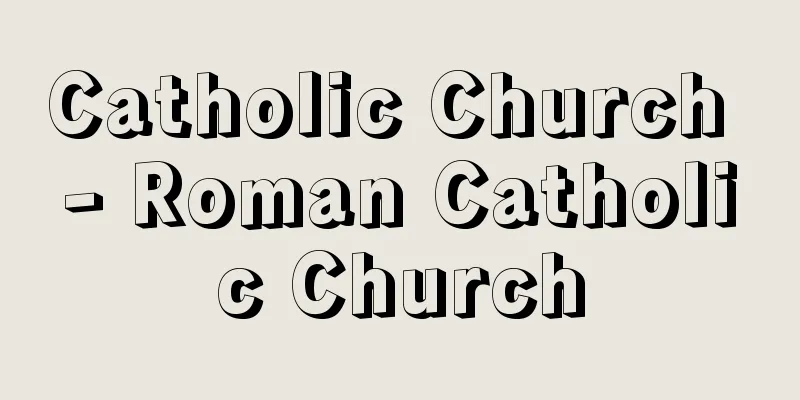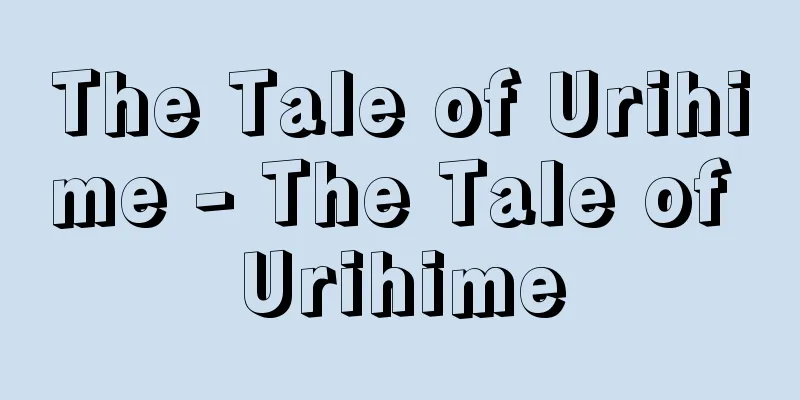Catholic Church - Roman Catholic Church

|
In Christian churches, the term refers to the Roman Catholic Church, whose head is the Pope, as distinguished from the Eastern Orthodox Church and Protestant churches. Catholicism means "universal," "universal," and "general," and is an expression that expresses the Christian Church's belief that it is "the one, holy, catholic, apostolic church" (Nicaean Creed, Constantinople Creed) and that it is the only institution of salvation for all mankind. The church was called the Catholic Church (ekklesia katholikē) (Greek) in a letter written by Ignatius, Bishop of Antioch, who was martyred around 110 AD, to the church in Smyrna. It is the largest church with approximately 1.044 billion members out of the approximately 1.974 billion Christians in the world (Britannica International Yearbook, 2000 edition). [Yamamoto Jouji] historyChristianity was brought to Rome by the activities of the twelve apostles and Paul, who preached that Jesus, who died on the cross and rose from the dead, was Christ, the promised Messiah and Savior. After severe persecution, Christianity gained a firm foothold in the Roman Empire with Emperor Constantine's conversion to Christianity and the Edict of Milan (313). After that, the churches in the Eastern and Western Roman Empires developed in different ways. In the Eastern Church, churches with different liturgies (systems of public worship) and a certain degree of autonomy and individuality were born, centered on the patriarchates of Constantinople, Alexandria, and Antioch. In contrast to the development of such diversity in the Eastern Church, the Western Church built a church organization with a common Roman liturgy centered on the Pope. However, despite differences in liturgy and language, the unity of the Catholic Church, which was the same apostolic handed down, was maintained until around the 5th century. Thus the doctrine of the Trinity was established at the Council of Nicaea (325) and the Council of Constantinople (381). However, the rejection of Nestorianism at the Council of Ephesus (431) and Monophysitism at the Council of Chalcedon (451) established the doctrine of Christology, but led to the separation and secession of some parts of the Eastern Church. Meanwhile, Pope Leo I made it clear that the Bishop of Rome had primacy over the entire Catholic Church, based on the Gospel of Matthew (Chapter 16, 18) and other sources. This was different from the view of the Eastern Church, which considered the Bishop of Rome to have the highest rank among its equal bishops. Then, the controversy over the destruction of images, the controversy over the appointment and dismissal of Patriarch Photius of Constantinople, and the Filioque controversy, in which the Western Church added the Latin phrase "Filioque," which is a plural emanation, to its creed, ignoring the Eastern Church's singular emanation, which holds that the Holy Spirit proceeds from both the Father and the Son, led to a split between the Eastern and Western Churches in 1054. The Eastern Church, which does not recognize the primacy of the Pope, came to call itself the Orthodox Church. After that, some churches recognized the primacy of the Pope while keeping the Eastern Church's liturgy, and became Catholic, but the majority of the Eastern Churches remained the same. Furthermore, with the Reformation in the 16th century, Protestant churches separated from the Roman Catholic Church, and as a result, the term Catholic Church came to have the limited meaning described at the beginning. The background and cause of the Reformation was the corruption within the church that had taken root in theology, liturgy, religious life, and church administration, and many people felt the need to purge it. The direct trigger of the Reformation was the controversy on indulgences that Martin Luther started in 1517. Combined with the political situation at the time, Luther's reform movement spread rapidly, mainly in Germany and Switzerland, and his followers left the Roman Catholic Church. However, the Reformation movement did not move in the direction of forming a unified Protestant church, and many churches split off according to their own beliefs. Therefore, it is not easy to clearly identify the differences in the beliefs of Protestant churches and the Catholic Church, but the differences in justification (freedom from all sins, including original sin), the Bible and Holy Tradition, the sacraments, priests, and the church are clear. The Catholic Church, which was forced to face these fundamental problems due to the Protestant Reformation, held the Council of Trent (1545-1563) to reflect on and reform its doctrines, organization, and systems. This was the conclusion of what is known as the Counter-Reformation, and became the starting point of modern Catholicism. After the 16th century, Europe lost its unity and modern nation states were born, and the Catholic Church concluded church-state concordats with these nations. In 1929, the Lateran Treaty was concluded with the Italian government, and Vatican City, the world's smallest independent state, was born, with the Pope as its head. During World War II, the Church provided assistance to people caught in the fire, regardless of religion, race, or nationality, and after the war it worked for peace. Pope John XXIII convened the Second Vatican Council (1962-1965), where discussions were held on the modernization of the Church in response to new global situations and ecumenism. The activities of John Paul II, who was elected Pope in 1978, were an extension of this Council, and he went beyond the role of head of the Catholic Church to begin working for world peace. He took an active diplomatic stance, visiting 120 countries around the world and establishing the image of a pope who takes action. He also visited Eastern Europe, South America, and even the Hindu country of India, spreading his message of peace to people all over the world. He also visited Japan in February 1981. In 1986, he became the first person in Christian history to visit a Jewish church, and in 1989, he met with Archbishop Runcy, the supreme leader of the Church of England, and signed a historic document of reconciliation. This document recognized the infallibility of the Pope and the universal supremacy of the Pope, including the Church of England, and committed the two churches to full friendship. In 1993, diplomatic relations between Israel and the Vatican were established. The Church also acknowledged previous mistakes by restoring the honor of Galileo Galilei, who had been put on trial for supporting the heliocentric theory, 300 years later (1992), and by essentially accepting Darwin's theory of evolution (1996). The Holy See designated the year around the year 2000 as a Jubilee Year of repentance for the past, and published a document on Christianity's past mistakes from a Catholic perspective, and made a confession to ask for God's forgiveness. The document was the Holy See's message for the world, and included a list of confessions for mistakes such as the division of Christianity, the Inquisition, the Crusades, criticism of science, and the de facto acceptance of the Nazi persecution of the Jews during World War II. In the same year, the Pope also visited the Western Wall, a holy site for Judaism, and the Temple Mount, a holy site for Islam, where the Al-Qa'sa Mosque is located. He met with religious and political leaders of the Jewish and Islamic worlds, with whom the two countries have had a history of conflict over the past 2000 years, such as the oppression of Jews in Europe and the dispatch of the Crusades, and appealed for historical settlement and reconciliation. In 2001, he visited three countries: Greece, Syria, and Malta. This was the first time in about 1,000 years since 1054, when Christianity split into East and West, that a Pope visited Greece, one of the bases of the Eastern Orthodox Church. [Yamamoto Jouji] Doctrine and LiturgyRegarding the fundamental concept of Christianity, liberation from sin, or justification, Protestants understand that we are justified only by believing in Christ's atonement on the cross and having faith in Christ, while Catholics understand that we are justified by baptism, a sacrament of faith. The Council of Trent said that "justification is not simply the forgiveness of sins, but the sanctification and renewal of the inner man through the voluntary acceptance of grace and various gifts" (Collection of Catholic Church Documents). Behind both views is the difference in the Reformers' thinking that human nature was destroyed by original sin, free will was lost, and lust itself is a sin, while the Catholic Church believes that only a special supernatural grace given by God was lost as a result of original sin, and that human nature, including free will, was not lost. Regarding justification, Protestant churches that claim "by faith alone" consider the Bible to be the sole source of faith, while the Catholic Church considers the Bible and the sacred tradition since the apostles to be the source of faith, and the Church Magisterium authoritatively interprets the Word of God for salvation. This difference affects the organization of the church and the entire way of religious life. The Catholic Church understands itself as a tool and place for realizing salvation through Christ, a "sacrament, so to speak." This is because God's work of salvation through Christ reaches people through the Church, and those who participate in that salvation belong to the organic community of the Church. Therefore, it places great importance on the seven sacraments that bestow the grace of salvation. The seven sacraments of Baptism, Eucharist (Holy Communion), Confirmation (strengthening the gifts of the Holy Spirit), Penance (Confession), Marriage, Holy Orders, and Anointing of the Sick (Extreme Unction) are rituals consisting of words and actions through which believers encounter God who works the work of salvation and receive the grace that the sacraments signify. These sacraments, including Baptism, which allows people to accept the faith, convert, and be accepted into the church community, are effective signs of the grace necessary at turning points in life. In particular, the sacrament of the Eucharist is at the center of the religious life of Catholic believers. The Mass in which the sacrament of the Eucharist is celebrated consists of two parts: the celebration of the word and the celebration of the Eucharist. The celebration of the word is the reading of Scripture, a sermon, and prayer. The celebration of the Eucharist commemorates Jesus' death on the cross and his resurrection, and participants share in Christ's redemption by receiving the bread and wine consecrated to his body and blood (Holy Communion). All believers are to participate in this Mass, especially on Sunday, the Sunday commemorating the resurrection of Christ. In addition, the Church has a special liturgical calendar, in which the history of salvation is celebrated throughout the year, centering on the birth of Jesus on December 25 (Christmas) and Easter in the spring. This Catholic church life, centered on the sacraments and liturgy, is very different from Protestant churches, which place preaching at the center of worship and only recognize two sacraments, baptism and the Eucharist. [Yamamoto Jouji] OrganizationThe Church is the "Mystical Body of Christ" and the "People of God" community of believers in Christ (Second Vatican Council), but at the same time, it is a centralized social and hierarchical organization centered on the Pope. The Church began when communities of believers were established in the areas where the twelve apostles, Paul, and their successors had preached. Those who belong to this community through baptism participate in the priesthood of Christ, the high priest, and all believers have the universal priesthood. However, services such as the performance of ceremonies in the Church are performed by those who hold the ministerial priesthood, the clergy (bishops, priests, and deacons). Bishops are the successors of the twelve apostles chosen by Christ, and priests and deacons (there used to be subdeacons as well) are collaborators of bishops. The clergy of the Catholic Church are limited to celibate men. In the Eastern Orthodox Church, married men can be ordained as priests, but marriage after becoming a priest is not permitted. Also, only celibate priests are appointed to the bishop position. In Protestant churches which recognize only a universal priesthood, such clergy do not exist. A bishop is the head of a parish, which is a local church, but all parishes around the world are under the Pope, the Bishop of Rome. In the Catholic Church, the Pope is the successor of the Apostle Peter and the highest authority and head of the Church. This was doctrinal clarification of the infallibility of the Pope at the First Vatican Council (July 18, 1870), and legalized in the 1917 Code of Canon Law (the revised Code of Canon Law was promulgated January 25, 1983). The Pope is also the sovereign of the Vatican City State. The Second Vatican Council (1962-1965) clarified the collegial nature and authority of the bishops, who govern the Church together with the Pope, who is its head. The most obvious way in which such authority is exercised is through ecumenical councils (religious councils). There have been 21 ecumenical councils to date, but the Eastern Orthodox Church only recognizes the first seven, up to the Second Council of Nicaea. The Council of Trent, where the issue of the Protestant Reformation was discussed, was the 19th ecumenical council. Since ecumenical councils are held very rarely, bishops' conferences are held in each local church, and at the ecumenical level, a synod of bishops is held every few years to exercise the pastoral function of the church by the entire bishops' body. In addition to these, there are cardinals who act as advisors to the pope in church administration and have the right to elect the pope. When the pope becomes vacant, the cardinals form a secret papal elective conclave to choose a successor. The centre of ecclesiastical administration for the whole Church is the Curia Romana (Latin) in Rome. The Secretariat of State plays a central and coordinating role, and since 1998 has been made up of the Secretariat of General Affairs and the Secretariat of Foreign Affairs. In addition, there are nine other ministries: the Congregation for the Doctrine of the Faith, the Congregation for Bishops, the Congregation for the Eastern Churches, the Congregation for Divine Worship and the Sacraments, the Congregation for the Clergy, the Congregation for Societies of Consecrated Life and Apostolic Life, the Congregation for the Evangelisation of the Pope, the Congregation for Canonisation, and the Congregation for Education. There are also three courts: the Penitentiary, the Court of Appeal (Rota), and the Supreme Court. In addition, since 1988, the Secretariat of Finance, the Secretariat of Accounts (Secretariat for the Interregnum of the Pontificate), and the Secretariat of Trusteeship have been established. In addition to these departments, new councils have been established: the Council of the Laity, the Council for Promoting Christian Unity, the Interreligious Council, the Council for Justice and Peace, the Council for the Family, the Council for Promoting Development Aid, the Council for Pastoral Care of Migrants and Itinerants, the Council for the Medical Apostolate, the Council for the Interpretation of the Laws, the Council for Culture, and the Council for Public Information. These efforts are an expression of an effort to examine from every angle the current Catholic Church, which has become extremely limited and "individualized" both culturally and religiously, and within Christianity, and to make it a truly universal Catholic Church. Another feature of the Catholic Church is that there are religious and secular orders separate from the diocesan organization under the bishop. Religious orders take vows to live according to the three gospel counsels of poverty, chastity, and obedience, and contribute to the Church through the missions they are given while living communally under the supervision of their superiors. Religious orders are divided into contemplative orders (such as the Carmelites and Trappists) dedicated to prayer and work, and active orders (such as the Franciscans, Dominicans, Jesuits, and Salesians). Secular orders, which take the same three vows as the above orders but also live in general society, have also become active. [Yamamoto Jouji] Catholicism in JapanThe Catholic Church in Japan began in 1549 (Tenbun 18) when Francis Xavier landed in Kagoshima, but the first period of the Christian era came to an end with the ban on Christianity (1612, Keicho 17), persecution, and national isolation (1641, Kanei 18). The second period of missionary work in Japan began in 1846 (Koka 3) when the Japanese Apostolic District was reinstated. In 1859 (Ansei 6), missionaries arrived in Edo and Hakodate, and in 1862 (Bunkyu 2) the first church was built in Yokohama. In 1865 (Keio 1), descendants of Christians were discovered at Nagasaki's Oura Cathedral. In 1876 (Meiji 9), the Catholic Church in Japan was divided into two dioceses, one in the south and one in the north, but as of 2000, it is divided into 16 dioceses, from Hokkaido (Sapporo Diocese) to Okinawa (Naha Diocese). The bishops who head these dioceses form the Catholic Bishops' Conference of Japan (Religious Corporation Catholic Central Council). As of 1998, the number of believers is approximately 460,000. [Yamamoto Jouji] "New Catholic Doctrine" by J. Van Brassel, translated by Yamazaki Toshiga (1976, Enderle Bookstore) " ▽ "Introduction to Christianity" edited by P. Nemecheggi (1980, Nansosha)" ▽ "Catholicism - Past and Future" by J. Daniel, J. Hol, and J. Poupal, translated by Asakura Tsuyoshi and Kurata Kiyoshi (1981, Jordan Bookstore)" ▽ "The Teachings of Christ" by Ronald Lawler, translated by Goto Heikichi and others (1983, Chuo Shuppansha)" ▽ "Summary of Church History" by A. Franzen, translated by Nakamura Yutaro (1992, Enderle Bookstore)" ▽ "New World Catholic Church History - The Trend of Ecumenism" by T. Bokenkotter, translated by Ishii Kengo (1992, Enderle Bookstore)" ▽ "Collection of Documents of the Catholic Church" by Heinrich Denzinger, translated by Hama Kangoro (1992, Enderle Bookstore)" ▽ "Learning about the Church's Essence and Challenges" edited by Momose Fumiaki (1995, San Paulo) ▽ "Catholics and Protestants" edited by Tokuyoshi Yoshikazu and Momose Fumiaki (1998, Enderle Bookstore)" ▽ "The Church as the Original Sacrament" by O. Semmerroth, translated by Ishibashi Taisuke (1999, Enderle Bookstore)" [References] | | | | | | | | | | | | | | | | Order| | | | | | | | | | | | | |Counter | | | | | | |Source: Shogakukan Encyclopedia Nipponica About Encyclopedia Nipponica Information | Legend |
|
キリスト教の教会で、東方正教会(オーソドックス教会)、プロテスタント諸教会と区別して、ローマ教皇を頭(かしら)とするローマ・カトリック教会をさす。カトリックとは、「普遍的」「公同的」「一般的」という意味のことばで、自らを「唯一、聖、カトリック、使徒伝来の教会」(ニカイア信条、コンスタンティノープル信条)と信じているキリスト教会が、全人類のための唯一の救いの機関であることを表す表現である。教会がカトリック教会ekklesia katholikē(ギリシア語)とよばれたのは、紀元110年ごろ殉教したアンティオキアの司教イグナティオスがスミルナの教会にあてた手紙においてである。 全世界キリスト教徒約19億7400万人のうち、約10億4400万人の信徒を有する最大の教会である(『ブリタニカ国際年鑑』2000年版)。 [山本襄治] 歴史十字架上で死んで復活したイエスを、キリスト、すなわち約束のメシア、救い主であると宣教した十二使徒やパウロの活動によって、キリスト教はローマにもたらされ、激しい迫害ののち、コンスタンティヌス皇帝のキリスト教改宗とミラノ勅令(313)により、ローマ帝国に確固とした地盤を築いた。その後、東西両ローマ帝国の領内において、教会はそれぞれ趣(おもむき)の違った発展を遂げていった。東方教会では、総大司教区となったコンスタンティノープル、アレクサンドリア、アンティオキアを中心に、異なった典礼(公的な礼拝執行の体系)をもち、ある意味での自律性と独自性をもった諸教会が生まれていった。このような多様性のある東方教会の発展とは対照的に、西方教会ではローマ教皇を中心とし、共通のローマ典礼をもった教会組織が築き上げられた。しかし、典礼や言語による表現の相違はあっても、5世紀ごろまでは、同じ一つの使徒伝来のカトリック教会としての一致は保たれていた。そのようにして、ニカイア公会議(325)およびコンスタンティノープル公会議(381)において三位(さんみ)一体の教義が確立された。 しかし、エフェソス公会議(431)におけるネストリウス主義の排斥、カルケドン公会議(451)におけるキリスト単性論の排斥は、キリスト論の教義を確立しはしたが、東方教会のいくつかの部分の分離脱落を結果することとなった。その間に教皇レオ1世は、ローマの司教が、全カトリック教会に対して首位権をもつものであることを、『マタイ伝福音(ふくいん)書』(16章18)などを基礎にして明らかにした。これは東方教会の意識とは異なったものであった。東方教会では、ローマの司教を、同等の司教たちのなかで第一の位を有する者と考えていたからである。そして、聖画像破壊論争、コンスタンティノープルの総大司教フォティオスの任免をめぐる論争、三位一体の教義に関して、聖霊は父より子を通して発出すると考える単数発出論の東方教会を無視して、西方教会が、聖霊は父と子の両者から出るという、複数発出論のラテン語「フィリオクエ」とよばれる表現を信経(信条)に付け加えたフィリオクエ論争などが重なって、1054年、東西両教会は分裂した。ローマ教皇の首位権を認めない東方教会は自らをオーソドックス(正)教会とよぶことになった。その後、東方教会の典礼を保ったまま、ローマ教皇の首位権を認め、カトリックになった教会もあるが、東方教会の大勢はそのままである。 さらに16世紀の宗教改革によって、プロテスタント諸教会がローマ・カトリック教会から離れた結果、カトリック教会という語は、冒頭に書いたような限定された意味となった。 宗教改革の背景とも原因ともなったものは、神学、典礼、信仰生活、教会行政などの面に巣くっていた教会内部の腐敗であり、多くの人々がその粛正の必要を感じていた。宗教改革の直接のきっかけは、1517年マルティン・ルターによってなされた贖宥(しょくゆう)論争である。当時の政治的状況とも相まって、ルターの改革運動はドイツ、スイス地方を中心として急速に広まり、その信奉者たちはローマ・カトリック教会から離れるに至った。しかし、宗教改革運動は、一つのまとまったプロテスタント教会を形成する方向には向かわず、多くの教会がそれぞれの信仰に従って分立することになった。そのためプロテスタント諸教会とカトリック教会の信仰内容の相違を明確にすることは容易ではないが、義認(原罪を含むすべての罪からの解放)、聖書と聖伝、秘蹟(ひせき)(サクラメント)、司祭、教会などに関する相違は明らかである。宗教改革によって、このような根本的な諸問題に直面することとなったカトリック教会は、トリエント公会議(トレント公会議、1545~1563)を開き、教義や組織・制度について反省・刷新を図った。これがいわゆる反宗教改革とよばれるもののまとめであり、近代カトリック主義の出発点となった。 16世紀以後はヨーロッパの統一が失われ、近代国家が誕生してくると、カトリック教会はこれらの国家と政教条約を結ぶ。1929年にはイタリア政府とラテラノ条約(ラテラン協定)を締結し、教皇を首長とする世界最小の独立国バチカン市国が誕生する。第二次世界大戦では教会は、戦火に巻き込まれた人々を宗教、人種や国籍の別なく援助し、戦後は平和のために努力した。教皇ヨハネス23世は第二バチカン公会議(1962~1965)を開き、会議では世界の新情勢に即応した教会の現代化と教会一致(エキュメニズム)などについて討議がなされた。 1978年教皇に選出されたヨハネ・パウロ(ヨハネス・パウルス)2世の活動はこの公会議の延長上にあり、カトリックの長という領域を越え、世界平和のための活動を始めた。積極的な外交姿勢をとり世界120か国を訪問し、行動する法王のイメージを確立した。東ヨーロッパ各国、南アメリカ、さらにヒンズー教国のインドなどにも訪問して世界中の人々に平和のメッセージを伝えた。1981年2月には日本にも来訪した。 1986年にはユダヤ教の教会をキリスト教史上初めて訪問、1989年にはイギリス国教会の最高指導者ランシー大司教と会談し、歴史的和解文書に調印した。この文書は教皇の不可謬(ふかびゅう)性とイギリス国教会をも含む教皇の普遍的最高権を認め、両教会の完全な親交に努めるというものである。1993年にはイスラエルとバチカンの国交が樹立された。 また、地動説を支持して宗教裁判にかけられたガリレオ・ガリレイの名誉を300年たって回復させ(1992)、ダーウィンの進化論を事実上容認する(1996)など、それまでのカトリック教会の過ちを認めた。 教皇庁は西暦2000年を挟んだ1年を、過去を悔い改める大聖年と位置づけ、カトリックの立場からみたキリスト教の過去の過ちに関する文書を公表し、神の許しを請う懺悔(ざんげ)を行った。文書は教皇庁が世界に向けて発する大聖年のメッセージとされ、そのなかにはキリスト教の分裂、宗教裁判、十字軍の遠征、科学への批判、第二次世界大戦中のナチスによるユダヤ人迫害に対する事実上の容認などの過ちに対する懺悔が列挙されている。また同年、教皇はイスラエルにあるユダヤ教の聖地「嘆きの壁」やイスラム教の聖地であるアクサモスクのある神殿の丘を訪れた。ヨーロッパでのユダヤ人弾圧や、十字軍の派遣など、過去2000年の間、対立の歴史を刻んできた相手であるユダヤ教やイスラム教世界の宗教・政治指導者などと会談し、歴史の清算と和解を訴えた。 2001年には、ギリシア、シリア、マルタの3か国を歴訪した。教皇が東方正教会の拠点の一つであるギリシアを訪問するのは、キリスト教が東西に分裂した1054年以来、約1000年ぶりのことである。 [山本襄治] 教義と典礼キリスト教の根本概念である罪からの解放、つまり義認について、キリストの十字架上の贖罪(しょくざい)を信じキリストへの信仰のみによって義認されるとするプロテスタント側の理解に対して、カトリックにおいては信仰の秘蹟である洗礼によって義認されるとする。トリエント公会議では「義化(義認)とは単に罪が赦(ゆる)されるだけでなく、人間が自発的に恩恵と種々の賜物(たまもの)とを受け入れることによる内的人間の聖化と一新である」(『カトリック教会文書資料集』)とした。両者の背景には、原罪によって人間本性が破壊され、自由意志が失われ、情欲そのものが罪であるとした宗教改革者側の考え方と、原罪によって失われたのは、神から与えられた特別な超自然的な恩恵だけであって、人間本性は自由意志を含めて失われてはいないとするカトリック教会との考え方の相違がある。 また義認において、「信仰のみ」を主張するプロテスタント諸教会は、信仰の源泉に聖書を唯一のものとするが、カトリック教会は、聖書とともに使徒以来の聖なる伝統を信仰の源泉とし、教会教導職が救いのための神のことばを権威をもって解釈する。この相違は教会の組織、信仰生活のあり方全体に影響するものである。 カトリック教会は、教会自身をキリストによる救いを実現する道具・場、「いわば秘蹟」と理解している。神がキリストによって行う救いの営みは、教会を通して人々に及び、その救いにあずかる人々は、教会の有機的共同体に属することになるからである。したがって、救いの恵みを与える七つの秘蹟を重視する。洗礼、聖体(聖餐(せいさん))、堅信(聖霊の賜物(たまもの)を強化)、ゆるし(告解)、結婚、叙階、病者の塗油(終油)の七つの秘蹟は、ことばと行為からなる儀式であるが、その儀式によって信徒は救いの働きを営む神に出会い、その秘蹟が意味する恩恵を受け取るのである。人が信仰を受け入れ回心して教会共同体に受け入れられる洗礼をはじめ、これら秘蹟は人生の節目に必要な恩恵の効果的しるしである。とくに、聖体の秘蹟はカトリック信徒の信仰生活の中心になっている。聖体の秘蹟の行われるミサは、ことばの祭儀と感謝の祭儀の二つの部分からなっている。ことばの祭儀は、聖書の朗読、説教および祈りである。感謝の祭儀は、イエスの十字架の死と復活を記念し、キリストの体と血に聖別されたパンとぶどう酒を参列者が拝領すること(聖体拝領)によって、キリストの贖(あがな)いにあずかるのである。このミサは、とくにキリストの復活を記念する主日である日曜日には、信徒全員が参加することになっている。 また、教会には特別の典礼暦があり、12月25日のイエスの降誕(クリスマス)と春の復活祭の二つを軸にして、1年間を通して、救いの歴史が祝われるようになっている。このような秘蹟と典礼を中心にしたカトリックの教会生活は、説教を礼拝の中心に置き、秘蹟は洗礼と聖餐(聖体)の二つだけしか認めないプロテスタント諸教会とは大きく異なっている。 [山本襄治] 組織教会は「キリストの神秘体」であり、キリストを信ずる人々の共同体「神の民」(第二バチカン公会議)であるが、それは同時に、ローマ教皇を中心とした中央集権的な社会的・位階的組織である。教会は、十二使徒、パウロならびにその後継者が宣教した地方に、信じる者の共同体がつくられることによって始まった。洗礼によってこの共同体に属する人は、大祭司であるキリストの祭司職に参与し、すべての信徒は普遍的祭司職をもつことになる。しかし、教会における祭儀の執行等の奉仕は、役務的祭司職を有する者、聖職者(司教・司祭・助祭)によって行われる。司教は、キリストによって選ばれた十二使徒の後継者であり、司祭と助祭(かつては副助祭もあった)は司教の協力者である。カトリック教会の聖職者は独身の男子に限られる。東方正教会では、妻帯者も司祭に叙階されるが、司祭になってからの結婚は認められない。また、司教には独身の司祭だけが登用される。万人(普遍的)祭司職だけを認めるプロテスタント諸教会には、前述のような聖職者は存在しない。 司教は地方教会である教区の長であるが、全世界の教区は、ローマの司教である教皇(法王)のもとに置かれている。カトリック教会における教皇は、使徒ペテロの後継者であり、教会の最高権威者、頭である。このことは、第一バチカン公会議における教皇の不可謬(ふかびゅう)権の教義決定(1870年7月18日)によって教義的に明確にされ、1917年の教会法典(改訂教会法典は1983年1月25日公布)によって法制化された。教皇はまたバチカン市国の主権者でもある。第二バチカン公会議(1962~1965)は、頭である教皇と一体となって教会をつかさどる司教の団体性とその権限を明らかにした。そのような権限がもっとも明瞭(めいりょう)な形で行使されるのが公会議(宗教会議)である。公会議はこれまで21回行われているが、東方正教会は第二ニカイア公会議までの最初の7回の公会議だけを認めている。宗教改革の問題が論じられたトリエント公会議は第19回目の公会議である。公会議はごくまれにしか開かれないので、全司教団による教会司牧の機能を行使するものとして、各地方教会には司教協議会が、そして全教会レベルでは数年ごとに世界代表司教会議(シノドス)が開催されるようになった。これとは別に、教会の統治について、教皇の顧問として教会行政にあたり、教皇選挙権をもつ枢機卿(すうききょう)(カーディナル)がある。教皇が空位になったとき、後継者を選ぶ教皇選挙秘密会議(コンクラーベ)は枢機卿によって構成される。 全教会に対する教会行政の中枢はローマの教皇庁Curia Romana(ラテン語)である。中心になり調整の役割を果たすのは国務省で、1998年以降は総務局と外務局からなっている。そのほかに、教理省をはじめ、司教省、東方教会省、典礼・秘蹟省、聖職者省、奉献・使徒的生活会省、福音布教省、列聖教、教育省の九つの省があり、内赦(ないしゃ)院、控訴院(ロータ)、最高裁判所の3裁判所が置かれている。そのほか1988年以降は財務局、会計局(教皇空位期間事務局)、管財局が設置されている。これらの諸部門のほかに、新たに評議会として、信徒評議会、キリスト教一致推進評議会、諸宗教評議会、正義と平和評議会、家庭評議会、開発援助推進評議会、移住・移動者司牧評議会、医療使徒職評議会、法文解釈評議会、文化評議会、広報評議会が設置された。これらはカトリック教会が、文化的にも宗教的にも、そしてキリスト教のなかでも、きわめて限定されたもの、「個別的」なものになっている現状を、あらゆる面から検討し、真の意味で普遍的なカトリック教会にしようとの努力の表れである。 司教のもとにある教区の組織とは別に修道会、在俗修道会があるのもカトリック教会の特色である。修道会は、清貧、貞潔、従順の三つの福音的勧告に従って生きる誓願をたて、長上のもとに共同生活を営みながら、与えられた使命を通じて教会に貢献する。修道会は祈りと労働に捧(ささ)げられた観想修道会(カルメル会、トラピスト修道会など)と活動修道会(フランシスコ会、ドミニコ会、イエズス会、サレジオ会など)に分けられる。またこのような修道会同様に三つの誓願をたてはするが、一般の社会生活を行う在俗修道会も活躍するようになった。 [山本襄治] 日本のカトリック日本のカトリック教会は1549年(天文18)フランシスコ・ザビエルが鹿児島に上陸したときに始まったが、まもなく起こった禁教(1612=慶長17)、迫害、鎖国(1641=寛永18)によって、第1期にあたるキリシタン(切支丹)時代は終わる。日本への宣教の第2期は、1846年(弘化3)日本代牧区が復活したときに始まった。1859年(安政6)には宣教師が江戸と函館(はこだて)に渡来、1862年(文久2)には横浜に最初の教会が建てられた。1865年(慶応1)長崎大浦天主堂でキリシタンの子孫が発見された。 1876年(明治9)日本カトリック教会は南緯、北緯の二つの代牧区に分けられたが、2000年現在では、北海道(札幌教区)から沖縄(那覇教区)まで16の教区に分かれている。これら教区の長である司教は、日本カトリック司教協議会(宗教法人カトリック中央協議会)を形成している。1998年現在信徒数は約46万人。 [山本襄治] 『J・ヴァン・ブラッセル著、山崎寿賀訳『新カトリック教理』(1976・エンデルレ書店)』▽『P・ネメシェギ編著『キリスト教入門』(1980・南窓社)』▽『J・ダニエル、J・ホル、J・プーパル著、朝倉剛・倉田清訳『カトリック――過去と未来』(1981・ヨルダン社)』▽『ロナルド・ローラー著、後藤平吉他訳『キリストの教え』(1983・中央出版社)』▽『A・フランツェン著、中村友太郎訳『教会史提要』(1992・エンデルレ書店)』▽『T・ボーケンコッター著、石井健吾訳『新世界カトリック教会史――エキュメニスムの流れ』(1992・エンデルレ書店)』▽『ハインリッヒ・デンツィンガー著、浜寛五郎訳『カトリック教会文書資料集』(1992・エンデルレ書店)』▽『百瀬文晃編『教会その本質と課題を学ぶ』(1995・サンパウロ)』▽『徳善義和・百瀬文晃編『カトリックとプロテスタント』(1998・エンデルレ書店)』▽『O・ゼンメルロート著、石橋泰助訳『原サクラメントである教会』(1999・エンデルレ書店)』 [参照項目] | | | | | | | | | | | | | | | | | | | | | | | | | | | | | | | | | | | | | | | |出典 小学館 日本大百科全書(ニッポニカ)日本大百科全書(ニッポニカ)について 情報 | 凡例 |
<<: "Unification of the Catholic Church"
Recommend
Medial moraine (English spelling)
...the bottom of a glacier is filled with rock de...
Being and Time (English: Sein und Zeit)
This is the major work of German existential phil...
Futomani - Futomani
A type of divination used in ancient times. It in...
Uqayl Dynasty - Uqayl Cho (English spelling)
A semi-independent Islamic dynasty (c. 990-1096) t...
Gas turbine cycle
…jet engine [Theory and thermal efficiency] The o...
Taraxacum koksaghz (English spelling) Taraxacum koksaghz
…[Yoshiharu Iijima]. … *Some of the terminology t...
Tarsus - Tarsus (English spelling)
A city in Icher Province in the south-central par...
New Japanese Literature
The journal of the New Japan Literary Association...
Abashiri River
A river that flows north through the southern par...
name reaction
...This has shed light on the degree of likelihoo...
Shuksha - Wild siamese cardamom
A perennial plant of the ginger family with fragra...
Togasawara (English spelling) Japanese douglas fir
An evergreen tall tree of the pine family native t...
Rebound tumbling
… In the United States, it was adopted as a train...
Drinks - Nominryo
〘noun〙① Something to drink. Inryo. ※Sakehon Kairan...
Azuma Kunitayu - Azuma Kunitayu
⇒ Tokiwazu Kanetayū (2nd generation) Source: Kodan...


![Constitutional Evolution - Kenpouhensen (English spelling) Verfassungswandlung [Germany]](/upload/images/67cb81cb5d1c1.webp)






